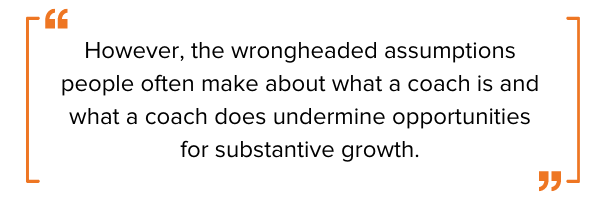A couple of weeks ago, a few members of our team were fortunate enough to overhear a conversation that demonstrated how professional coaches often overstep and create unintended roadblocks for those they’re supporting.
We were eating lunch at our favorite deli just a few blocks from the old office (we’re now all remote and taking our own medicine as we adjust to remote conversations). At the table across from us were sitting a distinguished-looking older gentleman and an energetic guy who’d clearly been making waves in his industry. We’d gathered from early on in their conversation that not only was this the start of a new mentoring relationship, but it was also a celebration.We picked up bits and pieces of the conversation as we finished our sandwiches, and we imagine it went something like this:
“Congratulations, Chase!” the older gentleman said. “VP of Learning and Development—that’s a huge step up in the world. I know you’ve been working hard towards this promotion for quite some time. How does it feel?”
“It’s pretty amazing. My wife screamed when I told her,” Chase said.
The older gentleman smiled and leaned back in his chair, “I bet. She knows firsthand how much time and energy you’ve dedicated to this.”
“Definitely! But I’ve got to step up my game. Our company’s had massive turnover in the past year, and there aren’t any signs of that trend reversing anytime soon.”
“Yeah, a lot of industries are struggling right now. But let me ask you something, Chase: what’s the average employee’s work-life balance look like in your company?”
“It’s par-for-the-course, I guess. We’ve got the standard 40-hour workweek, but nobody punches a clock. There’s always a mad rush to meet client deadlines. And with more people leaving every week, late hours and on-call weekends are fairly commonplace.”
The older gentleman raised his eyebrows. “That’s not a sustainable business model. Can I give you some friendly advice? I’ve been at this a long time, and I can tell you: your business lives or dies based on employee satisfaction. Point blank. Their negative perception not only impacts retention, but eventually, it’ll trickle down and get the attention of your customers, if it hasn’t already.”
“Exactly,” Chase nodded and glanced around the room. “But the real question I have is this: what can I do now to begin making things better?”
“One word,” the older gentleman revealed a slight grin. “Empathy. Show your employees you understand what they’re going through. You could even make a bold move. Encourage the other members of your leadership team to give employees a mandated holiday with pay. Have them turn off their computers and close up shop for an entire three day weekend.”
Chase’s face was completely blank. “That’ll cost us,” he said.
“Yes, it’ll cost you. But this kind of thing communicates that you care about more than only the bottom line. Just remember, though; you have to follow this up with action. In our next meeting, we can start plotting out how you can help your employees feel more appreciated and fulfilled. That’s going to be the key to turning this mess around.”
Unfortunately, at that point, we broke our cover and had to avert our attention. What can we say, we’re passionate about the power of effective coaching. But what we just witnessed … let’s just say it made for some interesting conversations on slack in our team chat that afternoon.
Redefining the Coaching Conversation
We know what you’re thinking. The guy’s advice seemed spot on. If a super-famous, not-to-be-named tech company is doing this sort of thing, then there just has to be something to it. Well, sure. BUT, that super-famous, not-to-be-named tech company is not Chase’s company. Their circumstances and contexts are not the same. Our point? The older gentleman gave Chase a band-aid when what he needed was to cut open the proverbial wound and dig out the infection before it gets worse. And the BEST way to arrive at deeper, more transformative solutions is through effective coaching conversations.
However, the wrongheaded assumptions people often make about what a coach is and what a coach does undermine opportunities for substantive growth.
At Fierce, we define coaching as “the process of developing others to generate and embrace their own solutions.”
And this definition makes all the difference. Here’s why.
1. It requires personal responsibility and is therefore repeatable.
The best coaches don’t give advice. We might sound a bit off our rocker when we say that, but hear us out. While the older gentleman’s advice will certainly help Chase, advice in itself simply doesn’t have growth potential. It’s hard to further nuance, reshape or reapply as circumstances change. In a word, it’s static.
However, by encouraging Chase to take ownership over resolving his problem for himself and providing appropriate support through that process, an effective coach would enable him to develop a critical thinking practice that could sustain him throughout his career. Remember the old adage: teach someone to fish and you feed her for a lifetime? It might sound cliche, but it’s so true, especially in the context of a coaching relationship.
2. It encourages depth of understanding and allows more well-rounded solutions to blossom.
By urging Chase to drill down and think about his situation for himself, an effective coach could help him see the problem with greater depth and clarity, and to generate more thoughtful and lasting solutions for himself. For instance, if asked the right questions, Chase might’ve uncovered that his office culture as a whole is toxic, and that the women in that space are repeatedly talked over, marginalized, and even sometimes publicly maligned. Chase might’ve realized that this toxicity is actually what’s driving his high turnover rate, not work-life balance issues.
 In this specific context, a three-day weekend is probably only good for giving employees the mental space they need to realize they deserve better. Taking the older gentleman’s advice and calling it a day eliminated an extraordinary opportunity to get to the real root of the problem. This discovery would’ve informed Chase on how to institute a host of more relevant initiatives to transform his employees’ day-to-day experiences.
In this specific context, a three-day weekend is probably only good for giving employees the mental space they need to realize they deserve better. Taking the older gentleman’s advice and calling it a day eliminated an extraordinary opportunity to get to the real root of the problem. This discovery would’ve informed Chase on how to institute a host of more relevant initiatives to transform his employees’ day-to-day experiences.
3. It connects the head and the heart, laying the foundation for lasting change.
Let’s face it. Change is hard. And in order for it to stick, most of us require an emotional connection to it. Chase had a clear set of steps to fulfill that could seemingly set him on the path of improving employee retention. But notice how the only person in the above scene who seems emotionally invested in this checklist is the mentor. Chase’s indifference to it means there’s a high probability that he’ll slip back into old habits and won’t expend the energy needed to resolve his problem.
Meanwhile, flipping the script and guiding him to uncover solutions for himself instantly grants him the emotional investment needed to catalyze long-term action. And that translates to ongoing results as his circumstances evolve.
The point here is that in order to enable others to create deep, genuine change in their lives, your coaching conversations MUST begin recognizing and relying on the wellspring of insights simmering just beneath the surface not of the coach, but of each individual.
Want to transform your coaching conversations into something truly empowering? Start here.

Learn How to Have Better DE&I Conversations
Bring this powerful virtual keynote featuring Karith Foster into your organization today!




